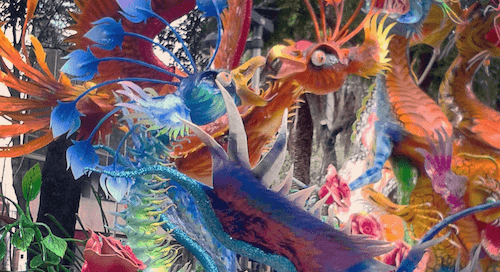Eight Key Elements to interpret Mexican Art & Design
Arriving to Mexico, often in transit through the capital Mexico City, the folk arts are everywhere: on the street, in hotels/houses/guest houses, at fairs and festivities (all year round), in museums, etc.
But... Where do Mexican artisans/artists/designers get so much creativity from?
To find it out, we took a tour into one of the many temples of folklor art and design in Mexico City, the Folklor Art Museum (Spanish : Museo de Arte Popular or MAP), in the historic center of Mexico City, which is inscribed on the World Heritage Site by the United Nations Educational, Scientific and Cultural Organization (UNESCO). The MAP is located in a magnificent 1929 art deco building designed by Vicente Mendiola Quezada (1900-1993), this building initially served as a fire department.
We found at least eight key elements to decipher the mysteries of Mexican creativity.


Giant papier-mâché fantastic creatures called “alebrijes” in Reforma street (left), and Mendiola’s building (right).
#1. Natural riches
Mexico is crossed by the Tropic of Cancer (Northern Tropic) and mountain ranges that run just like a snake from north to south and from east to west. Also, Mexico has coastlines overlooking the Atlantic (the Gulf of Mexico), the Pacific and the Caribbean Sea. These characteristics provide it with a variety of climates and amazing landscapes: deserts, volcanoes, coasts, mangroves, forests (tropical, temperate and pine), huge basins with majestic water mirrors, hills, cenotes, etc. And this extraordinary diversity is reflected in the ecosystems and biodiversity, making Mexico one of the twelve "megadiverse" countries, that is, with the greatest number and diversity of plants and animals in the world.

Modern pitcher, The Castillo family, Taxco, material Silver and jade, MAP museum.
#2. Raw materials
Therefore, we understand the immense variety of raw materials available: clays, woods, resins, minerals, volcanic stones (obsidian, “tezontle”), fire stones (blue) and water stones (green as jade), canes, flowers, vegetable fibers, “guajes” (inedible pumpkins), corn leaves, seeds, fruits, shells, mother-of-pearl, corals, feathers, skins, metals, and many more.


“The seven mortal sins oxcart”, Carlomagno Pedro Martínez, modeling clay, San Bartolo Coyotepec, MAP (left) Painted Pumpkin Container, Guerrero, Franz Mayer Museum (right).
#3. Everyday, sumptuous and sacred objects
This great diversity of materials has been used since ancient times both for the elaboration of daily life artifacts, from agriculture, fishing, clothing, cooking as well as for ritual activities, such as for the elaboration of sumptuous garments and sacred objects.

#4. Identities
Mexico is made up of 32 States and thousands of villages, neighborhoods and communities, which have developed their own artifacts, testifying strongly rooted local identities: both at the level of techniques and knowledge and at the level of designs, beliefs, festivals and rituals. Thus, in many cases, the designs are inspired by mythological traditions and local festivals, in the rural or urban environment and of course in the fauna and flora.
 Monkey, Jacoba y Maria Angeles, San Martín Tilcajete, Oaxaca, carved polychromatic wood
Monkey, Jacoba y Maria Angeles, San Martín Tilcajete, Oaxaca, carved polychromatic wood
#5. The pre-Hispanic Mesoamerican cultural tradition
The Mesoamerican cultural tradition is present in all aspects: in the raw materials, techniques and in the cosmogony. To have an idea on the Mesoamerican cosmogony, you may refer to our articles on “Cosmic Designs” and on “Corn mythology” here in the site.
#6. New Spanish cultural affiliation
With the arrival of the Spaniards, the introduction of Christianity on the one hand and the trade route to Asia on the other, brought new raw materials, new techniques and of course new beliefs. Virgins, saints and Christ replaced the old gods. The churches replaced the old temples above the pyramids, leaving the sacred objects of the cult totally modified. Thus, the Mexican Baroque art developed beautiful art of carved and painted wooden statues, covered with gold leaves that reproduced with sumptuousness and preciousness of the fabrics of the dresses, to make them look real. this is the art of the “estofado”, a name inspired in the precious fabrics. From Asia came the lacquered byóbus, literally the “wind wall”, that is the Japanese folding screens and furniture inlaid with mother-of-pearl and ivory.

They came in such quantities that they inspired to forever stay in the arts of New Spain until today. Many of those techniques that arrived in the Nao of China, the name for the Manila galleon, persist and integrate many of the popular arts, in particular those that were located in the route between Acapulco and Veracruz.
#7. The mestizajes
Some of the most interesting aspects are all the crossbreeds that have been produced as a result of all these cultural influences. Between the materials, the techniques, the cosmogony, the craftsmen/artists, the places, all the combinations and mixtures are possible. Sometimes with the integration of new techniques (vitrified ceramics) or materials (glass). Other times with the continuity and evolution of old techniques such as the “maque”, a magnificent local Mexican painting of lacquered aspect. On other occasions imported techniques from the west and the east gave birth to new local techniques and design, which was the case of the “enconchados”, easel paintings of religious inspiration inlaid with mother-of-pearl shell. In others, ancient techniques were used for the new cosmogony as in the case of the “totomoxtle” technique, which uses corn leaves to give life to nativity scenes.


#8. Abilities
Each piece or artifact is a universe with diverse cultural affiliations, techniques, materials, identities and the extreme ability and dexterity of its creators.
About our Author:
Marion Du Bron, Founder of DestinationMEX
 Historian PhD, School of High Social Sciences Studies (EHESS), Paris.
Historian PhD, School of High Social Sciences Studies (EHESS), Paris.
She has lived in Mexico since 2003.
Unconditionally passionate for Mexican history and culture.
Entrepreneur and coach for foreigners.



0 comments